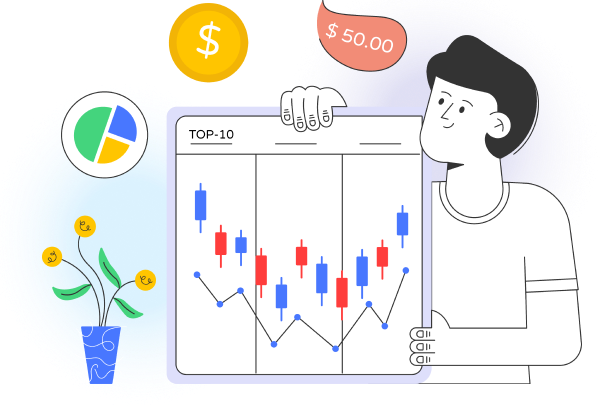


One effective day trading strategy involves focusing on specific trading sessions, with each presenting different opportunities based on varying liquidity, volume and volatility
Oftentimes traders examine price patterns on a smaller scale to identify useful buy and sell signals
Traders viewing chart intervals of 1-minute, 5-minute, or 15-minutes can often identify vital support and resistance levels that might otherwise be invisible on higher time frames
Successful crypto day trading demands a blend of savvy planning, fierce discipline, and a willingness to self-educate. In this article, we discuss the best day trading strategies for aspiring crypto prop traders.
Day trading in the cryptocurrency market can be a thrilling and rewarding experience for those who enter it with a well-defined trading strategy.
Let’s take a look at some of the optimal trading strategies day traders use to navigate the fast-paced and volatile world of the crypto market.
The cryptocurrency market runs 24/7; however, opportunities become available at various intervals throughout the day as traders in London, New York, and Tokyo come online.
An effective approach to day trading involves focusing on specific trading sessions. Each session presents different opportunities owing to varying market liquidity, volume, and volatility.
Known for its high liquidity and volatility, the London trading session is one of the most significant periods in the global market. Traders have been known to capitalize on consistent behavior patterns observed around the London open.

For instance, it’s common to see major spikes in volatility and directional moves during this time. By analyzing previous patterns, traders can anticipate these movements and position themselves accordingly.
An example might include setting up trades that anticipate a surge in buying activity at the London open.
The New York trading session overlaps with the London session, creating an extremely important window for day traders that is rife with activity.
The New York open has often been characterized by instances of heavy selling, which provides opportunities for day traders who recognize this pattern.
Having studied market behavior during the New York open, traders can adjust their positions and strategies to benefit from these predictable moves.

The daily opening price of a given asset can serve as a useful foundation upon which to base a day’s trading strategies, often acting as either a support or resistance level throughout the day.
The simplest form of the daily open strategy involves observing how the price of an asset reacts to the daily open and using it as a support level if the price remains above the daily opening price throughout the day. Conversely, if the price stays below the daily opening price, traders can use it as a resistance level.

Taking the daily open strategy one step further, traders often incorporate a daily bias into their strategies. If the market sentiment is bullish, the trader may look to buy when the price of an asset dips below the daily open, with the expectation that the overall bullish sentiment will enable it to move higher.
Likewise, in a bear market, the trader might look to sell above the daily open, based on the view that the market will carry it lower throughout the day. This approach requires a keen understanding of market trends and sentiment to determine the daily bias accurately.
Basing trading strategies on broad market movements can only yield so much. Sometimes traders must examine price patterns on a smaller scale to identify useful buy and sell signals. Identifying support and resistance levels on lower time frames can provide precise entry and exit points that are not visible on higher time frames.
Traders observing chart intervals of 1-minute, 5-minute, or 15-minutes can often find crucial support and resistance levels that would otherwise be invisible on higher time frames. These can prove pivotal in making successful short-term trading decisions. For example, a 5-minute chart might show a support level that aligns with multiple price bounces, indicating a strong short-term buy signal.
Various technical indicators can also be used effectively when applied to shorter time frames; these are known as low time frame indicator strategies.
Bollinger Bands plot price points one standard deviation above and below an asset’s moving average and can be very useful in identifying overbought or oversold conditions in the cryptocurrency market. This tool is especially beneficial for crypto proprietary trading firms and individual traders operating within prop trading firms.
On lower time frames specifically, Bollinger Bands can be used by traders to spot potential reversal points. For instance, some traders enact a strategy whereby they buy when the price touches the bottom band and sell when the price reaches the top band. This approach allows traders to capitalize on short-term market movements, which is crucial for crypto prop trading.
For crypto proprietary trading firms, understanding and utilizing Bollinger Bands can significantly enhance trading strategies. By closely monitoring the asset’s price movements relative to the bands, traders can make more informed decisions, thereby improving their trading proficiency. This method is particularly effective in the highly volatile cryptocurrency market, where rapid price swings can occur.

Moreover, incorporating Bollinger Bands into the broader spectrum of risk management strategies is essential. It helps traders to establish clear entry and exit points, thus mitigating potential losses. For instance, when a price consistently hits the lower band, it may signal an oversold condition, suggesting a potential buy opportunity. Conversely, when the price reaches the upper band, it could indicate an overbought condition, signaling a possible sell.
For those in crypto prop trading firms, integrating Bollinger Bands into daily trading strategies can optimize performance. It is not only about identifying the buy and sell signals but also about understanding the broader market context. By doing so, traders can better navigate the crypto market’s volatility and enhance their overall trading strategies.
In the world of proprietary trading, particularly within crypto proprietary trading firms, the use of moving average crossovers is a pivotal strategy for traders. Short time frame observance of moving averages can significantly aid traders operating in crypto prop trading firms, allowing them to make timely entries and exits in the cryptocurrency market.
Moving averages, such as the 5 EMA (Exponential Moving Average) crossing above the 20 EMA, can signal potential bullish trends, making it an ideal entry point for traders. Conversely, a bearish crossover occurs when the short-term moving average crosses below the long-term moving average, signaling a potential sell opportunity.

For best crypto prop trading firms, understanding and leveraging moving average crossovers is essential. This strategy not only helps in identifying market trends but also in enhancing overall trading proficiency. The dynamic nature of the cryptocurrency market, with its high volatility and rapid price movements, makes moving average crossovers an invaluable tool for traders.
Incorporating moving average crossovers into broader trading strategies can optimize performance. For example, traders can combine this strategy with other technical indicators to confirm signals and increase the accuracy of their trades. This multi-faceted approach is particularly beneficial for crypto proprietary trading firms looking to maximize profits while managing risk effectively.
Moreover, moving average crossovers are integral to developing robust risk management strategies. By setting predefined entry and exit points based on these crossovers, traders can mitigate potential losses and capitalize on profitable opportunities. This approach aligns well with the goals of crypto prop trading, where precision and timing are critical to success.
For individual traders within crypto proprietary trading firms, mastering moving average crossovers can lead to greater success and consistency in their trading career. This strategy not only enhances their trading skills but also contributes to the overall success of the firm by achieving higher profitability and reduced risk.
Momentum and the Relative Strength Index (RSI) are crucial components in the arsenal of proprietary trading firms, especially within the dynamic environment of crypto proprietary trading firms. These indicators provide essential insights into market conditions, helping traders operating in prop trading firms make informed decisions.
The RSI is a valuable tool for identifying overbought and oversold conditions in the cryptocurrency market. This technical indicator measures the magnitude of recent price changes to evaluate whether an asset is overbought or oversold.

On lower time frames, an RSI above 70 indicates an overbought market, suggesting a potential sell opportunity. Conversely, an RSI below 30 signals oversold conditions, indicating a potential buy opportunity. For crypto proprietary trading firms, integrating the RSI into their trading strategies can enhance the accuracy of entry and exit points.
Combining the RSI with other technical indicators can provide a more comprehensive view of market trends. For example, pairing the RSI with moving average crossovers or Bollinger Bands can confirm signals, reducing the likelihood of false entries and exits. This multi-layered approach is particularly beneficial for crypto prop trading, where market volatility is a constant challenge.
Momentum indicators focus on the speed and direction of price movements, offering insights into the strength of a trend. In the context of crypto proprietary trading, momentum continuation plays a significant role. By analyzing the performance of various assets over the past few days, traders can identify strong or weak performers.
This strategy involves buying assets that have shown strength, expecting the trend to continue, and selling those that have exhibited weakness. This approach relies on the assumption that strong trends are likely to persist, making it a reliable method in the highly volatile cryptocurrency market.
For traders in crypto prop trading firms, momentum indicators can provide an edge in identifying market opportunities. By tracking the persistence of strong trends from previous days, traders can capitalize on ongoing momentum, optimizing their trading strategies for better results. This method is especially useful for proprietary trading firms focusing on short-term gains and rapid market movements.

For crypto proprietary trading firms, combining momentum indicators with the RSI can significantly enhance trading strategies. This integration allows traders to identify not only the strength of a trend but also the overbought or oversold conditions of an asset. By doing so, traders can make more informed decisions, improving their trading proficiency and overall performance.

For example, a trader might use the RSI to identify an oversold condition in a strong momentum asset. This combination suggests a potential buy opportunity, as the asset is likely to continue its upward trend.
Conversely, identifying an overbought condition in a weak momentum asset signals a sell opportunity. This strategic approach helps traders operating in crypto proprietary trading firms optimize their trades, managing risk more effectively while maximizing potential profits.
The integration of momentum and RSI indicators is vital for traders within a crypto prop trading firm. These tools provide critical insights into market conditions, enhancing the accuracy of trading strategies.
By leveraging these indicators, traders can navigate the complexities of the cryptocurrency market with greater confidence, achieving better results in their trading career. The use of momentum and RSI indicators not only improves trading skills but also contributes to the overall success of proprietary trading firms, positioning them as competitive players in the financial markets.

Success in crypto prop day trading demands strategic planning, discipline, and continuous learning. By employing strategies such as session-based trading, daily open techniques, low time frame support/resistance, and momentum plays, aspiring crypto prop traders can navigate the volatile cryptocurrency market more effectively. These approaches help traders in proprietary trading firms to make informed decisions, optimize trades, and manage risks, ultimately enhancing their trading proficiency and overall success.